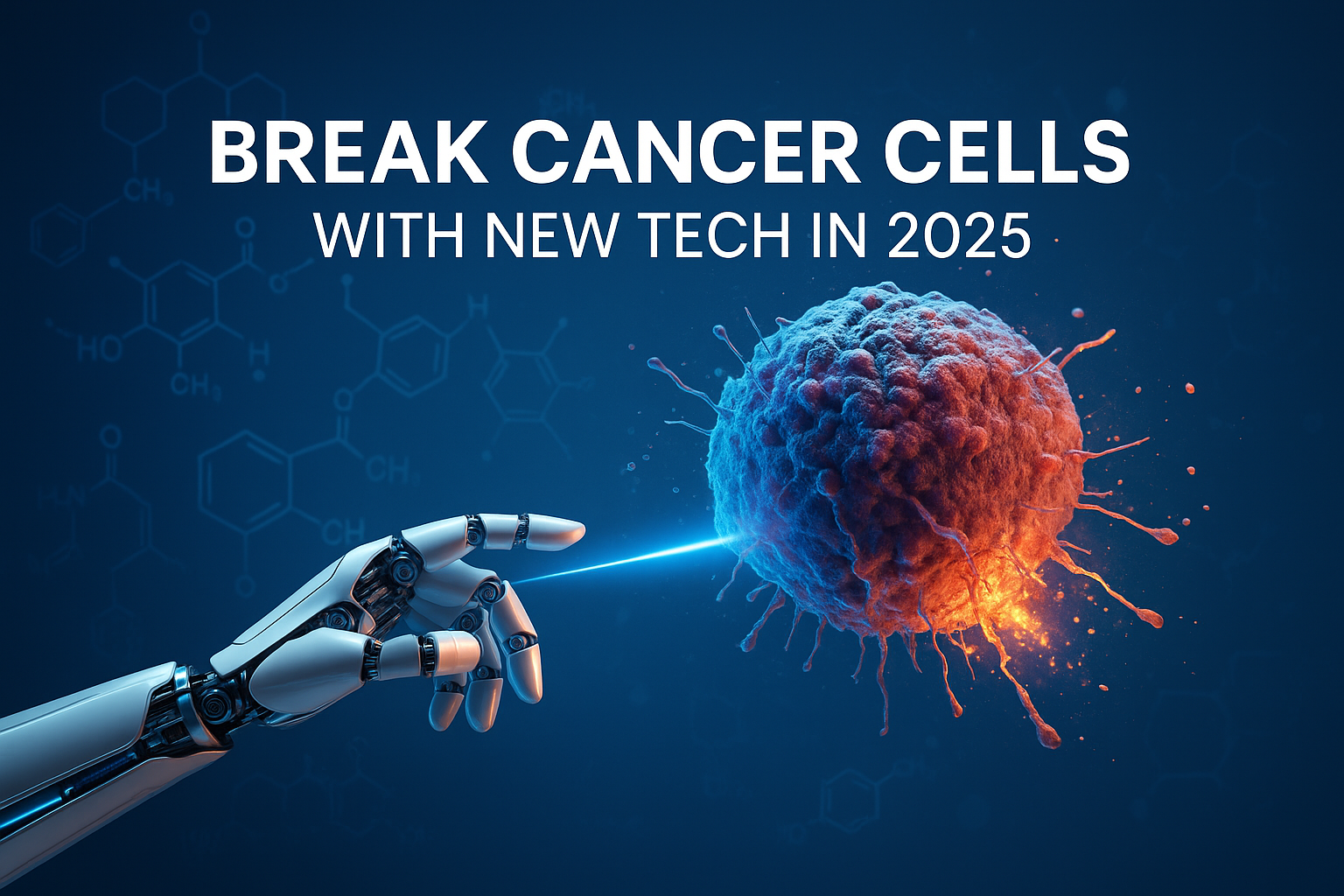Cancer isn’t invincible—but breaking cancer cells means much more than killing them. Whether through molecular jackhammers, mechanical disruption of cancer cell membranes, or apoptosis (programmed cell death), the goal is clear: destroy cancer cells with precision and minimal harm to healthy tissue. Emerging physical methods, like vibrating molecules triggered by near‑infrared light, can literally punch through membranes—offering hope beyond chemotherapy or radiotherapy and bypassing drug resistance.
Cancer is diagnostic disease and it’s to harmful. In this article, we’ll explore how these cutting‑edge techniques “break” cancer at the cellular level, why traditional therapies sometimes fail (hello, micro metastases and resistance), and what it really means when we say, “break cancer cells.” Let’s dive in.

How Cancer Cells Resist Death:
Cancer cells are clever survivors. To avoid apoptosis—a natural form of programmed cell death—they often ramp up anti‑apoptotic proteins like BCL‑2 and Bcl‑xL while disabling pro‑apoptotic signals (like p53 or BH3-only proteins). This mechanism helps them evade treatment that normally prompts programmed cell death. They also develop drug resistance by adapting over time: some cancer cells in micro metastases hide in low-drug areas, evolving to survive and repopulate tumours later. Meanwhile, the tumour’s microenvironment—via signalling pathways like PI3K/AKT and Ras—further shields these cells from therapy. In essence, cancer hijacks both biochemical pathways and its surroundings to outsmart treatment.
Another survival tactic is autophagy, where cancer cells recycle parts of themselves to endure stress such as nutrient deprivation, hypoxia, or therapy. Additionally, epigenetic changes and heterogeneity allow certain cells—sometimes early cancer stem cells—to persist and resist multiple drugs. These resistant pockets, often undetectable, are the root of cancer recurrence. That’s why methods that aim to mechanically disrupt cancer cell membranes or use molecular jackhammers hold promise: they can physically “break” cells instead of relying on pathways that cancer has learned to dodge.
Cutting‑Edge Physical Methods to Destroy Cells:
One of the most exciting breakthroughs is the use of molecular jackhammers—tiny amino cyanine dyes that attach to cancer cell membranes and vibrate under near‑infrared light, forming a Plasmon that mechanically ruptures the membrane. In lab studies, this led to a staggering 99% destruction of cancer cells and even cancer-free mice in melanoma models.
Another promising technique is oncotripsy: using low-intensity ultrasound at the cancer cell’s resonance frequency to physically disrupt their cytoskeleton and nuclear envelope. This mechanical disruption of cancer cell membranes results in DNA damage and triggers cell death, with healthy cells left unharmed.
Both methods bypass biochemical drug resistance and apoptosis evasion, offering a precision-focused alternative to conventional chemotherapy or radiotherapy. By physically “breaking” cancer cells, these molecular machines could revolutionize how we destroy cancer at the cellular level.
Chemical + Biotech “Breakdown” Methods:
An exciting area is suicide gene therapy (gene-directed enzyme prodrug therapy). It involves inserting a viral or bacterial gene into cancer cells, which converts a harmless pro-drug into a toxic one—destroying targeted disease cells while sparing healthy tissue. Studies show this method works well even in chemotherapy-resistant cancer cell lines and can help control hidden micro metastases using nanoparticles for delivery support.
Another biotech avenue: immunotherapy, specifically checkpoint inhibitors. These drugs (like PD‑1, PD‑L1, and CTLA‑4 blockers such as nivolumab, pembrolizumab, and ipilimumab) reactivate T cells so the immune system can find and destroy cancer cells on its own. Clinical success is growing—especially in melanoma and lung cancer—with some patients seeing durable remission.
Finally, oncolytic viruses (e.g., T-VEC) infect cancer cells, forcing them to burst (“lysis”) and release immune-stimulating agents like GM-CSF—creating a one-two punch of physical cell rupture and immune activation.
Together, these chemical and biotech methods offer precision ways to break cancer cells, complementing molecular jackhammers, oncotripsy, and traditional chemo radiotherapy.
Preclinical to Clinical: Where Therapies Stand:
Molecular jackhammers have shown 99% destruction of cancer cells in vitro and cured about 50% of melanoma mice, with researchers aiming for human clinical trials within 5–7 years. Meanwhile, oncotripsy—using low-intensity ultrasound tuned to cancer cells’ resonance—has proven effective in lab studies and animal models, selectively disrupting tumours without harming healthy cells.
Additionally, focused ultrasound therapies, including HIFU and histotripsy, are already in early human trials. For example, the NHS recently introduced histotripsy in patients with liver tumours, and UVA Health is combining focused ultrasound with immunotherapy in melanoma and brain cancer trials.
These methods bypass traditional drug resistance and apoptosis evasion, offering precision, non-invasive treatment that could potentially revolutionize cancer care.
Addressing Pseudoscience & Safety Concerns:
It’s tempting to believe in so-called “natural cures” like cannabis oil, alkaline diets, castor oil, and Laetrile. However, cannabis oil—despite buzz online—has no clinical evidence as a cancer cure, and misleading hype on social media can delay proper treatment and worsen outcomes. Similarly, Laetrile, often labelled “vitamin B17,” once claimed to target cancer cells, but was found ineffective and sometimes toxic—causing cyanide poisoning.
Historical therapies like Hoxsey herbal treatments and Gerson therapy promised cures via detox diets, enemas, and tonics. But extensive reviews by major medical bodies—including the FDA and National Cancer Institute—found no reliable evidence of benefit; some patients even suffered serious side effects. These examples highlight the danger of pseudoscience, unproven cancer cures, and medical misinformation.
To evaluate claims, look for peer-reviewed clinical trials, not anecdotal testimonials. Check trusted sources—Cancer Research UK, MSKCC, FDA—and ask your oncologist. By recognizing miracle cure myths and focusing on evidence-based medicine, patients can avoid harm and ensure they get proven, effective care.
Quality of Evidence & Clinical Data:
Evaluating new therapies requires understanding evidence levels—from preclinical study to Phase I/II clinical trials. The durable remission seen with checkpoint inhibitors like nivolumab and pembrolizumab—where ~20% of melanoma patients achieve long-term, treatment-free survival—highlights the strength of human data. Clinical studies look at endpoints like overall survival (OS), progression-free survival (PFS), and treatment-free survival. Early-stage trials focus on safety and toxicity, while later phases assess efficacy data in larger patient groups. Solid evidence comes from reliable clinical endpoints, peer-reviewed publication, and completion of rigorous trial phases—key factors for evidence-based medicine.
Looking Ahead: Future Directions:
Researchers are excited about combining molecular jackhammers with immunotherapy. By pairing near‑infrared-triggered membrane rupture with checkpoint inhibitors, the hope is to destroy cancer cells physically and then boost the immune system to clear any remnants (NIR penetrates deep and MJHs can’t be dodged by resistance).
Similarly, focused ultrasound therapies like HIFU are being paired with PD‑1/PD‑L1 antibodies in early clinical trials. These approaches not only physically break tumours but also trigger immune activation, sometimes causing a strong abs copal effect—where distant metastases shrink too.
Emerging strategies such as son dynamic therapy and mRNA vaccines (like mRNA‑4157/V940) further expand this precision immuno-mechanical toolkit. These developments mark a future where therapies break cancer cells through mechanical, genetic, and immunologic synergy—offering powerful, precision-targeted cancer breakdown with minimal harm to healthy tissue.
FAQ / Myth-Busters:
Q: Can vibrating molecules actually work in humans?
A: So far, molecular jackhammers using amino cyanine dyes and near-infrared-triggered membrane rupture have shown 99% destruction of cancer cells in lab and ~50% cure in animal models—but they are still preclinical with human trials expected in 5–7 years.
Q: Is ultrasound oncotripsy safe?
A: This ultrasound harmonic excitation targets cancer cell resonance to physically disrupt cytoskeleton and cell membranes without harming healthy cells—promising lab and animal results, though human data is not yet available.
Q: Can menstrual compounds like cannabis oil or baking soda break cancer cells?
A: No. Cannabis oil lacks clinical evidence as a cancer cure, and alkaline diets or baking soda are unsupported by rigorous trials—relying on them can delay effective therapy and cause harm .
Q: What is the abs copal effect?
A: It’s when a localized treatment (like focused ultrasound or radiation) triggers immune activation that shrinks distant tumours. Combining it with checkpoint inhibitors in trials shows promise, though it’s still rare in humans.
Conclusion & Call‑to‑Action:
Emerging therapies that break cancer cells are rewriting the future of oncology. Molecular jackhammers, powered by near-infrared-triggered membrane rupture, have achieved 99% destruction of cancer cells in vitro, with half the mice rendered cancer-free—signalling real promise for human treatment. Meanwhile, focused ultrasound modalities like HIFU, histotripsy, and oncotripsy are moving into early human trials—some even harness the abs copal effect by pairing with checkpoint inhibitors to boost immune response.
What makes these approaches exciting is their ability to physically disrupt cancer cell membranes, bypassing drug resistance, apoptosis evasion, and the challenges of micro metastases. Combining these physical technologies with immunotherapy—such as integrating MJHs with PD‑1 antibodies or deploying mRNA-4157/V940 vaccines—could deliver powerful, precise cancer cell breakdown with minimal harm to healthy tissue.
Still, it’s important to be patient. Most of these treatments are in preclinical study or early-phase clinical trials, with full safety, efficacy, and treatment-free survival data still forthcoming. But early results suggest a transformative shift in cancer care—from chemistry to mechanics, from chemicals to machines.
Call to Action: Stay informed by following FDA updates, reputable journals, and clinical trial registries. If you’re a clinician or researcher, consider contributing to trials combining mechanical disruption and immunotherapy. For patients and families, discuss emerging options with your oncologist, and share reliable resources. Together, we can move beyond traditional therapies and truly break cancer cells—literally and metaphorically.


